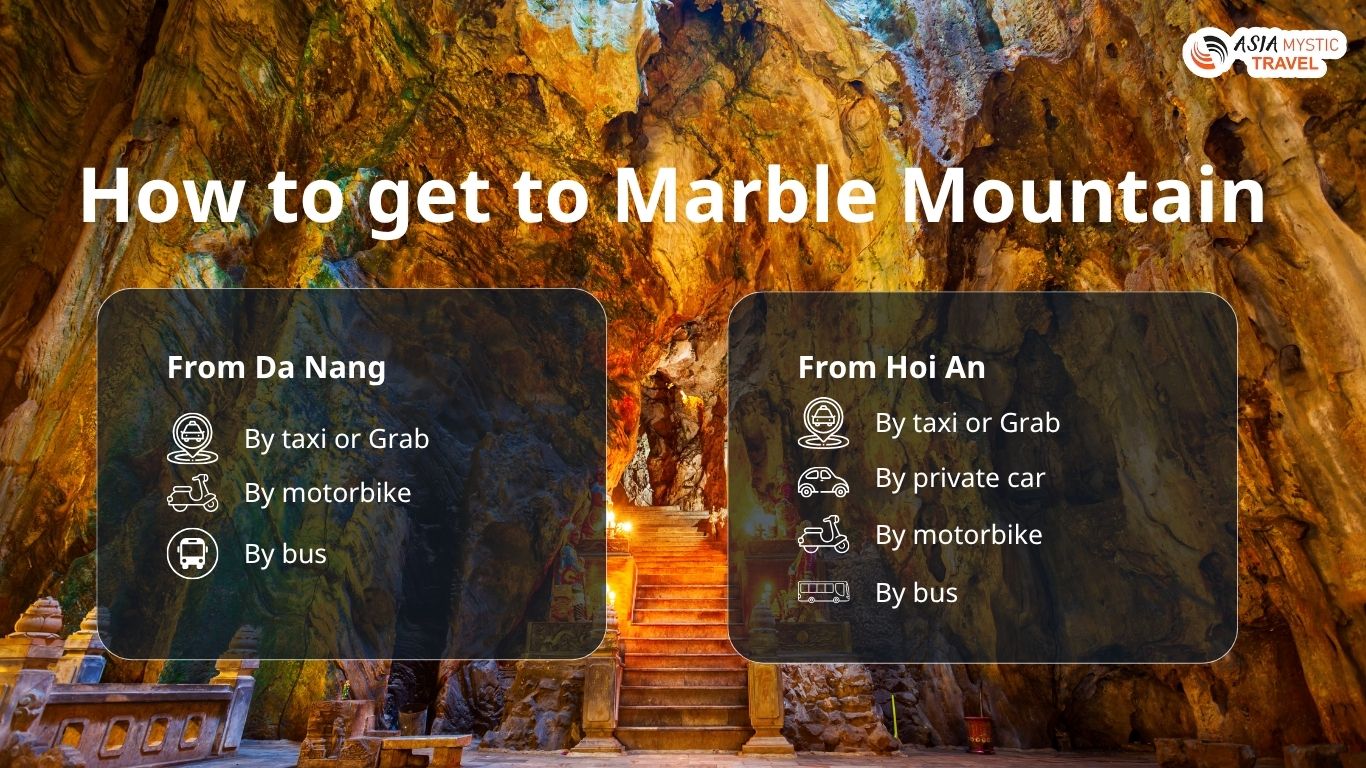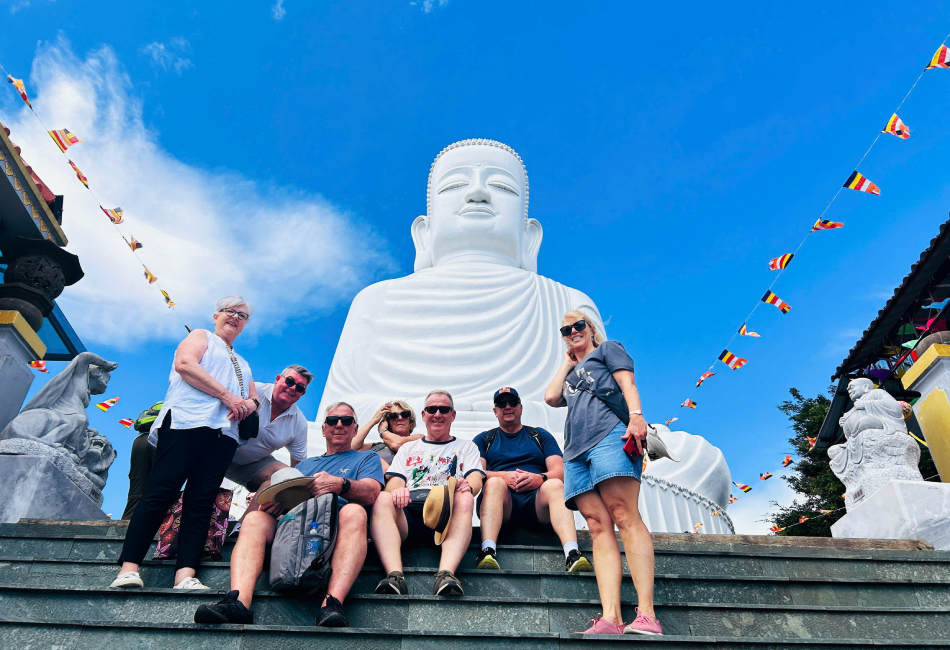
A Journey Through Marble Mountain In Da Nang
Overview of the Marble Mountains

Marble Mountains, locally called Ngũ Hành Sơn, are a remarkable cluster of five limestone and marble hills located about 9 kilometers south of Da Nang city, along Vietnam’s central coastline. These five hills are uniquely named after the five elements in Eastern philosophy: Kim (Metal), Mộc (Wood), Thủy (Water), Hỏa (Fire), and Thổ (Earth). Each mountain carries its own character and spiritual symbolism, contributing to the cultural and natural diversity of the area.
Historically, the Marble Mountains have been a sacred site for centuries. They house numerous ancient Buddhist pagodas, monasteries, and shrines, many dating back to the 17th and 18th centuries. The mountains’ extensive network of caves and grottoes was once used by Buddhist monks for meditation and worship, while some caves also served as hideouts during wartime.
The location of the Marble Mountains is also striking, perched between the South China Sea and lush hills, they offer breathtaking panoramic views of Da Nang’s coastline and cityscape. Today, the Marble Mountains remain one of Vietnam’s most important cultural landmarks and a popular destination for tourists seeking to experience a blend of natural beauty, history, and spirituality.
Entrance Fee to Marble Mountain
- Opening hours: Daily from 7:00 AM to 5:30 PM.
- Parking fees: Approximately 5,000 - 20,000 VND, depending on vehicle type and parking location.
- Best time to visit: Early morning (7:00–9:00 AM) to avoid crowds and enjoy cooler temperatures.
Destination | Entrance Fee | ||
Adults | Students | Children under 6 years old | |
Water Mountain | 40,000 VND/person | 10,000 VND/person | Free |
Am Phu Cave | 20,000 VND/person | 7,000 VND/person | Free |
Elevator Ride (one-way/round trip) | 15,000 VND / 30,000 VND | 15,000 VND / 30,000 VND | Free |
Note: The elevator operates from 7:00 AM to 5:30 PM and is not included in the standard entrance fee.
How to get to Marble Mountain

From Da Nang
Distance: Approximately 9 km (15–20 minutes by car)
- By taxi or Grab: A convenient option with fares ranging from 100,000 to 150,000 VND one-way. Reputable taxi companies include Mai Linh, Vinasun, and Xanh SM Taxi. You can also use ride-hailing apps like Grab for a comfortable ride.
- By motorbike: Renting a scooter offers flexibility and costs about 100,000 - 150,000 VND per day. The journey takes around 15 minutes via Võ Nguyên Giáp and Trường Sa streets. Parking is available near the entrance for about 10,000 VND.
- By bus: Local buses run between Da Nang and Hoi An, with stops near Marble Mountain. The fare is approximately 30,000 VND. Check local schedules for exact routes and timings.
From Hoi An
Distance: Approximately 20 km (30–40 minutes by car)
- By taxi: A one-way trip costs around 300,000 - 350,000 VND. Reputable taxi companies include Mai Linh, Vinasun, and Xanh SM Taxi. You can also use ride-hailing apps like Grab for a comfortable ride.
- By private car: Booking a private car offers flexibility and comfort, with fares ranging from 550,000 to 650,000 VND for a round trip. Services like DanangPrivateCar.com provide this option.
- By motorbike: Renting a scooter costs about 120,000 - 200,000 VND per day. The journey takes around 30–40 minutes via Trường Sa or Nguyễn Tất Thành streets. Parking is available near the entrance for about 10,000 VND.
- By bus: Local buses run between Hoi An and Da Nang, with stops near Marble Mountain. The fare is approximately 30,000 VND. Check local schedules for exact routes and timings.
The top attractive things at Marble Mountain
Huyen Khong Cave - The mystical sanctuary
Huyen Khong Cave is Marble Mountain’s most famous cave, renowned for its magical atmosphere created by natural light streaming through openings in the ceiling. Inside, you’ll find large, serene Buddha statues and Buddhist altars, making it a peaceful place for meditation and reflection. The interplay of light and shadows here offers incredible photo opportunities, especially in the early morning.
Linh Ung Pagoda – Peace amidst the peaks

Linh Ung Pagoda is a serene and beautifully maintained temple surrounded by greenery and sacred statues. Not to be confused with the larger Linh Ứng Pagoda near the Lady Buddha, this one is quieter and more intimate. Visitors come here to pray, enjoy the peaceful atmosphere, and admire its architectural details, including a striking statue of Avalokitesvara (Goddess of Mercy).
Tam Thai Pagoda - A historic spiritual center
Built in the 17th century, Tam Thai Pagoda is the oldest and largest pagoda on the mountain. It features classic Vietnamese Buddhist architecture with elegant wooden beams and stone sculptures. The pagoda overlooks the ocean, providing a stunning backdrop for visitors seeking both spirituality and scenic beauty. Many come here to pray, enjoy the tranquil gardens, and soak in the panoramic views.
Am Phu Cave – The cave of hell and heaven
Unlike the bright Huyen Khong Cave, Am Phu Cave is dark and mysterious, filled with stone statues depicting hellish scenes and spiritual guardians. This cave tells stories of the afterlife through its statues and carvings, offering visitors a glimpse into Vietnamese Buddhist beliefs about karma and reincarnation. Its eerie yet fascinating ambiance makes it a unique stop on your Marble Mountain tour.
Non Nuoc Stone Carving Village – Living marble art
At the foot of Marble Mountain lies Non Nuoc Village, famed for its marble carving tradition that dates back over 400 years. Visitors can watch artisans at work shaping beautiful statues, household items, and intricate souvenirs from raw marble blocks. The village also has shops selling handcrafted marble art, making it the perfect place to buy authentic keepsakes or gifts.
Warnings for visiting Marble Mountain
- Steep and slippery paths: The mountain trails and staircases are carved from marble and can be very slippery, especially after rain. Wear comfortable, non-slip shoes, and take your time when climbing or descending - some stairs are uneven and steep.
- Hot weather: Da Nang’s midday sun can be intense. If you're visiting in the dry season, plan for early morning or late afternoon. Bring a hat, sunglasses, sunscreen, and plenty of water to avoid heat exhaustion.
- Tourist traps exist: Outside the entrance, some vendors may offer unsolicited “tour help” or overpriced souvenirs. Always buy tickets at the official counter, and feel free to say "no thank you" politely.
- Keep an eye on your belongings: Marble Mountain is generally safe, but as with any busy tourist spot, it’s smart to keep your bags zipped and phones secure, especially in crowded caves or photo spots.
Top nearby attractions you shouldn’t miss
- My Khe Beach: Just 5–10 minutes from Marble Mountain, My Khe Beach is one of Vietnam’s most famous coastal stretches. Known for its soft white sand and calm, clear water, it’s perfect for swimming, sunbathing, or catching the sunrise. There are plenty of beachside cafés and seafood restaurants where you can relax after your mountain adventure.
- Asia Park & Sun Wheel: Around 20–25 minutes away, Asia Park blends cultural miniatures of Asia with thrilling rides and the massive Sun Wheel, one of the tallest Ferris wheels in the world. It’s ideal if you’re traveling with family or want a break from temples and nature.
- The Museum of Cham Sculpture: Just 15 minutes from Marble Mountain, this museum houses the largest collection of Cham artifacts in the world. If you’re fascinated by the cultural history behind Vietnam’s temples and carvings, this museum is the perfect add-on to your trip.
FAQs
Q: Where is Marble Mountain located?
A: Marble Mountain is situated just south of Da Nang city, about 9 km from the city center, along Vietnam’s central coast.
Q: What is the best time to visit Marble Mountain?
A: Early morning or late afternoon is ideal to avoid the midday heat and crowds. The dry season (February to August) offers the best weather.
Q: Is Marble Mountain suitable for children and elderly visitors?
A: The site involves climbing many stairs, so it may be challenging for some elderly visitors or very young children. The elevator can help reduce the climb, but doesn’t cover all areas.
Q: What should I wear when visiting Marble Mountain?
A: Modest clothing is recommended, covering your shoulders and knees, because Marble Mountain has active religious sites. Comfortable shoes are essential for walking and climbing.
Q: How much time should I allocate for visiting Marble Mountain?
A: Plan for about 2–3 hours to explore the caves, pagodas, and viewpoints comfortably.
Q: Is photography allowed inside the caves and temples?
A: Photography is generally allowed, but avoid using flash inside sacred areas to respect worshippers and preserve the artwork.
More than just a scenic spot, Marble Mountain (Ngũ Hành Sơn) is a rich blend of natural beauty, spiritual heritage, and vibrant local culture. Whether you’re a nature lover, history enthusiast, or simply seeking tranquility, Marble Mountain and its surroundings promise an unforgettable adventure.
Plan your visit well, respect the local customs, and immerse yourself fully in this iconic Vietnamese destination - your journey here will leave lasting memories.
>>> Drop us your request HERE, or choose what kind of contact options you prefer below:
- Hotline: +84963623907
- Email: info@asiamystictravel.com
- WhatsApp: +84963623907
Quick Contact
What do customers say about us?
Join us to experience a trip that will make you remember forever
